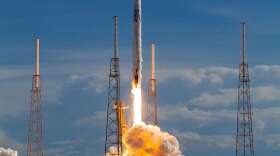What’s ahead for commercial space
Commercial space companies have played a critical role in the advancement of space exploration.
Private companies are working on giant new vehicles, like SpaceX’s Starship and Blue Origin’s New Glenn rocket, that will aid in missions to the moon and Mars within the next several years.
Anthony Colangelo, host of the podcast Main Engine Cutoff and co-host of the Off-Nominal podcast, said although the maiden launch of New Glenn failed to recover its booster, the mission overall was a steppingstone for the company and the vehicle itself.
“I think that still made it a lot farther than anyone else would have would have guessed,” Colangelo said. “Making it to orbit successfully in the first launch is something that I don't think has ever happened to that point on a commercial vehicle in this regard, especially one as big as this with really no run up.”
Again, the other massive rocket that is preparing for another maiden flight is SpaceX’s Starship. After the last test flight ended in an explosion and debris that rained down in the Caribbean Ocean, Colangelo said when Starship does launch again, it’s crucial it goes off without any issues.
“They've got to get this right,” Colangelo said. “They’ve had a series of failures with the Starship’s upper stage related to the engine, the Raptor engines, and they made some tweaks last time and thought they fixed the issue. Turns out, they had a similar issue, enough that it caused major concern. At a time when there's major scrutiny around SpaceX, [founder]Elon Musk, [and] all things Starship, making sure that you get this next one right and you don't have yet another video of debris raining across the Caribbean and southern parts of Florida is really important.”
When the International Space Station retires in 2030, commercial space companies will establish individual space stations – at least, that’s the plan. However, Colangelo said questions are still up in the air of how and when these companies will establish their own stations.
“To me, there's just never been enough money from the NASA side to really show that they're strongly committed,” Colangelo said. “That’s a tough chicken or the egg…are these companies going to build a space station for a market that they don't really know exists yet and depends on NASA being an anchor customer, while at the same time, NASA is not really funding themselves to be an anchor customer.”
We all sweat, even spacecraft
During reentry, a spacecraft experiences high speeds and is exposed to intense friction which makes the heat shield on vehicles extremely hot. Once back on the ground, it can take a long time to repair a spacecraft and get it ready for the next flight.
But Hassan Ifti, an assistant professor at Texas A&M University, is hoping to change the way engineers shield vehicles from the harmful effects of reentry with another way to protect a spacecraft: gas. Ifti said that heat exposure can reach extreme temperatures.
“All of that kinetic energy that you have when you're coming back home is being converted into heat, mostly because it's being stopped at the skin of the spacecraft, in this case,” Ifti said. “This generates a lot of heating, and the gas around your spacecraft would be about a little above 10,000 degrees Celsius, and then that heat can go into and will go into your vehicle.”
However, this gas shield would prevent the heat from entering the spacecraft, like how a puffer jacket works.
“For example, in the winter, you're wearing a puffer jacket,” Ifti said. “It keeps you warm, and the reason for it is the puffer jacket actually has lots of air in it. So, you kind of have a layer of air on top of you, which is stopping the heat from your body from going away to the atmosphere.”
With a gaseous shield, it would make the spacecraft look like it's sweating. Just like sweat is important for regulating the temperature of the human body, having gas acting as a shield protects a spacecraft from overheating.
“If the spacecraft is sweating a gas, then we would have a layer of gas on it, and that layer of gas would keep the heat from the hot gas away as it reenters Earth's atmosphere.”
With this technique, Ifti said having a better shield will also help reusability. Instead of having to prepare spacecraft shields after reentry, we could have mor reusable and faster launches.
“That would also bring space travel costs down,” Ifti said. “If you think about today, if you buy a new car, you're not just going to use it once. If an airline buys a new aircraft, they're not just going to go from, say, New York to London once and then throw it away. But that's what we're doing with our spacecraft today.”








